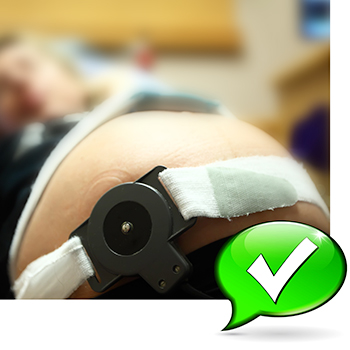
When a brain-injured infant is born and preventable medical error is suspected, the medical malpractice debate has been quick to focus on the usefulness of Electronic Fetal Monitors. Even though the tracings may have clearly showed an infant in distress – warnings that were misread or worse, ignored, by doctors and nurses at the bedside – the medical community has argued adamantly in court and elsewhere that the monitors aren’t useful, necessary, reliably interpreted, etc. ad nauseam, and therefore practitioners are not to blame for failing to heed them.
The latest major study on fetal heart monitoring says otherwise. In a paper presented at the Society for Maternal-Fetal Medicine on February 12, scientists came down on the side of using monitors. Researchers said that after examining data from more than 1.9 million single infant births, they concluded that the risk of infant death was 3.0 per 1,000 births for monitored babies and 3.8 per 1,000 births for babies born without fetal heart monitoring.
Furthermore, the scientists said that fetal health rate monitoring was also linked to a decreased risk of low Apgar scores (which reflect the baby’s health) in low-risk pregnancies. In high-risk pregnancies, monitoring was associated with a reduced risk of infant seizures.
As reported in the Baltimore Sun, the authors indicated that prior studies suggesting no difference in outcome with the use of fetal heart rate monitors “may not reflect the realities of everyday medicine.”
The reality of everyday medicine is that some 86% of all births in the U.S. now involve the use of Electronic Fetal Monitors (EFM). Doctors order these monitors. They obviously believe they are useful. Many times, as the latest study shows, the use of EFM has prevented death or injury to an infant. The only time the medical community seems to turn on EFM as a valuable technology is when they have been at fault for not using it correctly or heeding its warnings.
In my practice I have seen this happen scores of times. Monitor tracings are misread or, if read correctly, the appropriate response is delayed, or never occurs. At times a doctor is called by a worried nurse but, without justification, blows her off or drags his feet getting to the hospital.
Another little known debate about EFM occurs in the medical community itself; how to communicate about tracings using a common vocabulary. It wasn’t until June of 2009 that the American College of Obstetrics and Gynecology released new fetal heart monitoring guidelines with the stated goal of defining existing terminology and narrowing definitions and categories “so that everyone is on the same page.”
Over many years and even today, some practitioners may not speak the same monitoring language, with the result that patients are at risk.
This latest study should make it clear to the obstetrical community that it must not continue to blame EFM technology for their own shortcomings. Instead, it should put its energy toward teaching all doctors and nurses how to use it, how to interpret tracings correctly, and how to talk about it with each other using the same vocabulary.
It’s not much to ask.
RELATED POSTS
6 Questions to Ask Potential Medical Malpractice Lawyers
